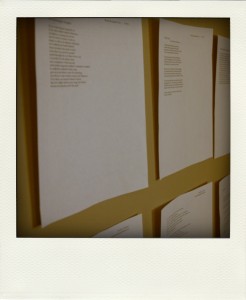
As the days have begun to grow shorter and colder, I’ve found myself delving more and more into “housekeeping” mode. Perhaps the barrage of commercial hoopla heralding the distant holiday season is partly to blame (astoundingly, the “seasonal” marketing seems to have started in September this year), but there is also something about the circumstances inherent in this particular change of seasons that seems to have kept me in a constant state of culling and curating, collecting and planning. This month, I’ve found myself flipping my closet; ruthlessly meal-planning to accommodate busy weeknights; moving and arranging furniture (I’ve just moved into a new office space at work); plotting out a steady stream of gifts (baby gifts, wedding gifts, Christmas gifts); and in the midst of it all—editing poetry.
These past couple of weeks, Mia and I have been hard at work puzzling out the order in which the poems in Issue 6 will appear. “Ordering” the poems in an issue is often one of the toughest parts of the editorial process for us, but it’s also one of the most significant (and the most rewarding!). It’s the first time in the process when an issue begins to take on a rough shape, and it’s this shape that serves as a guide for us as we develop and implement the visual elements of the issue (decisions about layout, typesetting, etc.) during the production process. When we think about ordering an issue, we consider not just the overall “arc” (with respect to things like theme, sonics, pacing), but also how each poem will speak to the poems on either side of it. Some poems automatically suggest points of entry, or finality, while others can help to build the energy of a sequence, or to create needed moments of breath or pause. We’re aware, of course, that as we are an online literary magazine, most people who encounter us are probably not in the habit of reading a given issue straight through (such is the nature of the internet, in which content is infinitely compartmentalize-able). But it is still important to us that there be a type of logic to how each issue is arranged—a sort of underlying lyric argument, if you will—to delight the reader who does choose to start at the front matter and read straight through.
Every time we finish ordering an issue, it feels like a red-letter occasion. I feel as if we’ve been given our first glimpse of a baby via ultrasound: the issue has begun to grown limbs; soon we will be able to see its tiny fingers and toes. Something about the outcome of the process feels life-giving, sustaining. I get a deep sense of satisfaction from experimenting with different arrangements, from asking how different configurations of the pieces in front of us might communicate differently as a whole, depending how they are arranged. Perhaps it’s partly my obsessive nature speaking (I am, after all, the kind of person who does not like the salad to touch the rice on her plate), but I think there is also something to be said for the benefit of this process of ordering, of arrangement—essentially, the act of editing—as a discipline for myself as an artist, as well. In stepping back from the work before us and considering how it operates in a greater context, I’m forced to think outside of myself and my own experience of any particular piece. I’m forced to think about the argument of the work we are presenting as a body, to craft an experience for the reader that is not only enjoyable and surprising, but also strategic in its emphasis. Do we want to place this very short poem between these two much-longer pieces? Perhaps yes, if there is enough of a sense of space in the short poem to create a needed pause or breath—but then again, perhaps not, if the shorter poem will be unfairly dwarfed by the longer pieces on either side of it. Do we want the reader to enter the issue in medias res—with a poem that provides the feeling of being invited along on a journey that’s already in progress? Or will the overall arc of the issue be better served by an entry poem that can serve as a sort of prologue for the trajectory of the work to come? If we place these two poems next to one another, do we risk the reader misunderstanding the first line of the latter because of the way that the former ends? If we don’t keep this group of poems in the order in which they came to us, are we violating the author’s intended sense of narrative? Or do we need to arrange these poems differently in order to create a more seamless transition between the group and the mood of the pieces that come before and after it?
In some sense, this type of conversation is not so different from the ongoing one that I, as a writer, must continually have with myself about my own work—whether on the level of the line, or on a more macro scale (at the level of a manuscript, or even at the level of archetype, or genre, or the critical fields of study with which my work is concerned). How do the elements that make up my body of work speak to one another, and how do they speak to the conversation that is already being held out there in the rest of the world? This is a set of questions that I must constantly ask myself if I am to remain engaged and grounded as an artist. Editing the work of others—and in particular, working on each new issue of LR—has simultaneously sharpened me as an editor of my own work. I’m a better artist for it, and I’m grateful for the opportunities it’s given me to challenge myself and to grow.